By Phil Molé, MPH
Welcome to the fifth and final installment of our blog series “Introduction to EHS Risks,” in which we’ll talk about the ways that good risk management is really the glue holding your EHS programs together. In case you missed our previous posts in this series, take a little time to check out our first installment for an overview of EHS risks, our second installment for an introduction to the benefits of using a risk matrix, our third installment for a discussion on the importance of selection and management of risk to your job as an EHS professional, and our fourth installment for an introduction to the bowtie analysis risk assessment tool.
Now, let’s talk about some of the specific ways that better EHS risk management can help you build and maintain a proactive EHS culture that leverages the knowledge and expertise of your entire workforce.
Promoting a Common Understanding of Risk
Before we jump in, a little review of the basics of EHS risks might be helpful here.
Way back in our first installment of this series, we focused on the central concept that everything you do as an EHS professional involves identifying and controlling risks, and that development of your risk management skills is central to your job effectiveness. But we also discussed how the sheer number of hazards (aka, sources of risk) complicates your task, especially since some categories of hazards (like “human factors” and “operational factors”) are not directly observable. For a refresher on major categories of workplace hazards, review the chart below.
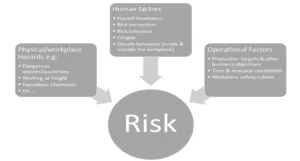
As we previously discussed, many EHS professionals focus only on the hazards they can see and often ignore human factors and operational factors, as well as the ways that different hazards can interact. Here’s a key takeaway: If you, as an EHS professional, sometimes struggle to identify and understand all the sources of risk in your workplace, how much more difficult do you think it is for your workers?
This leads us to the point that knowledge of workplace risks isn’t just important to your own skills development as an EHS professional, but also to all the employees you’re responsible for and to the ultimate potential for success of your EHS management system. It helps you to communicate the common understanding necessary to promote adoption of safe workplace practices and encourage better engagement with your safety programs.
Let’s review how we can specifically accomplish this using a couple of tools we’ve previously discussed: risk bowties and risk priority matrices.
Using Bowties to Communicate Risks
As we discussed in our last installment of this series, a risk bowtie is a useful communication tool because it pulls together all the relevant information about possible risk events into one place, where it’s easier to review and comprehend. For reference, look at the bowtie image below.
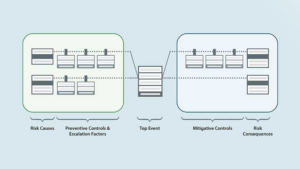
We call the entire sequence from risk causes to risk events and risk consequences a risk pathway, and by using the bowtie diagram, we can quickly take in all the details. By using bowties, we and our workforce can easily understand:
- the linkages between risk causes and the risk event, and between the risk event and subsequent risk impacts;
- a common understanding of how systems/processes work and their propensity to fail;
- what risk controls are in place;
- what escalation factors exist to reduce effectiveness of preventive controls; and
- how those controls act to reduce risk, and why they are only as effective as the person/process verifying they will work when expected.
Using a Risk Priority Matrix
In our second installment of this series, we talked about how the use of a risk matrix not only helps you prioritize your risks so you can be more effective and efficient at managing them, but also more easily communicate your key risk information to your employees. For a little review, check out the risk matrix below.
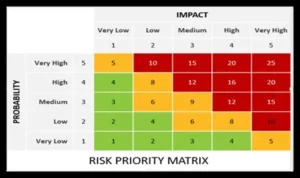
Risk matrices are readily understood in part because they’re so universal — they’re the lingua franca of the safety world. They also just make good visual sense. Anyone can look at the matrix and interpret key information about how many risk rankings are high, moderate, or low, and the color coding of green/yellow/red is clear and intuitive.
Promoting Better Worker Engagement
Another reason that a shared understanding of risk is important is that it’s a necessary ingredient for better employee engagement.
Having a workforce that’s actively involved in safety management is going to make everything about your EHS programs more effective because you’ll be sharing responsibility for safety, reducing your own workload, and tapping into the knowledge of workplace hazards and risks possessed by your employees. The importance of direct employee engagement with safety practices is so widely recognized that it’s specifically discussed in ISO 45001, the international standard for occupational health & safety (OHS) management systems. Section 5.4 of ISO 45001 states that effective OHS management requires the “consultation and participation” of workers, including those in non-managerial roles and temporary and contracted laborers.
There are several EHS risk management tasks that, in addition to accurately identifying and assessing workplace risks, provide great opportunities for worker consultation and participation. These include hazard identifications (HAZIDs), hazard and operability studies (HAZOPs), and risk bowties.
HAZIDs
We touched on HAZIDs in the fourth installment of this series. Basically, a HAZID is a method of breaking down workplace processes to identify hazards and controls, and to assess the effectiveness of controls at reducing risk.
The very nature of conducting HAZIDs leads to greater worker engagement. You complete a HAZID by assembling a team of people who have knowledge of the task or process you’ll be assessing, and then engaging them in a brainstorming session to identify major risks and initial controls to reduce risk to acceptable levels. HAZIDs are therefore occasions for your employees to directly participate in safety management through the crucial role of identifying risks and making the workplace safer for themselves and their coworkers.
You’ll get even more out of your HAZID exercises if you make sure you facilitate participation by giving everyone on the team a chance to contribute. Keep in mind that in any brainstorming session, there is the risk that one or two very vocal, assertive people will dominate the discussion, and unintentionally disincentivize others from sharing their thoughts. Make sure that all your team members have a chance to contribute. You’ll not only tap into the full potential of your team but will also show your employees that you care about their participation, and therefore make their future participation more likely.
HAZOPs
A HAZOP is a systematic assessment method that breaks down an existing process to look for places where deviations from original planned operation can occur. A common strategy is to conduct a HAZID first, as both a stopgap and preparatory method for conducting a HAZOP, which supplements our initial HAZID by accounting for risk controls.
Employees who participated in the HAZID exercise can participate in the HAZOP as well, using their HAZID input as a baseline for a deeper analysis. When you follow this strategy, you’re also helping employees to understand the importance of their contributions, because they can see how the knowledge and insights they share form the foundation for additional risk assessment and identification of controls.
Generating risk bowties
We’ve already discussed the fact that risk bowties make it easier for you and your employees to share and visualize a common understanding of risks, but that ease of comprehension also makes them a great tool for involving your workers directly in the process of mapping out risk pathways. This is especially true if you’re using modern operational risk software that lets you pull risk assessment information from multiple assessment formats including HAZIDs and HAZOPs, and easily keep your diagrams current as details about your operations and controls change.
By giving opportunities to your employees to participate and share their own knowledge of workplace risks, you’re also making your safety programs more effective and increasing the willingness of other employees to participate. Employees with better knowledge of risk pathways leading to an unwanted risk event will more consciously avoid behaviors and workplace practices that can set such an event into motion.
Promoting Better Worker “Buy-In”
That last point about encouraging participation is a nice segue to talking about “buy-in.” Many guides to EHS management talk about the importance of buy-in to safety performance, but what exactly is it?
Buy-in is related to engagement, but it’s not quite the same thing. Basically, you can have engagement without buy-in, but you’re not likely to sustain it.
“Buy-in” is not just about your employees participating in your management system – although of course that’s important. It’s about them believing that management is committed to improving safety and will listen to and act upon feedback provided by employees. It comes down to employees believing that their participation will make a difference, which in turn increases the likelihood that they’ll continue to participate.
It would be hard to underestimate the importance of this buy-in. Even if you are (or become) the most knowledgeable EHS manager ever known to exist, and even if all your written policies drip with the accumulated genius of a long EHS career, you’ll struggle to improve your EHS performance if your employees aren’t all-in on what you’re doing and motivated to participate.
“Buy-in” is about building and sustaining a healthy EHS culture, and there’s a dynamic interplay between your programs, your policies and your culture, as shown in the diagram below. Policies are about how to do things right, but the right culture is needed to do them right every time.
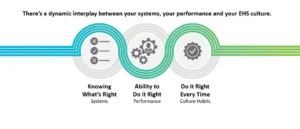
Another great benefit of better employee buy-in is that you’ll address a category of hazards often overlooked by other EHS professionals – namely, psychosocial hazards. You can think of psychosocial hazards as sources of anxiety resulting from work and/or the workplace, such as awareness of risks that aren’t being addressed, or uncertainty about what controls are in place. In fact, a 2018 study shows that employees who have a better understanding of risk pathways and controls self-report much lower levels of work-related anxiety.
Risk Management as Part of Your EHS/ESG Maturity Journey
As we’ve seen throughout this series, risk management helps you build a more cohesive and effective EHS management system in many ways:
- Visibility: You can become more adept at identifying all the sources of risk in your workplace, so that you’re not neglecting potential dangers to any segment of your workforce.
- Prioritization: Using a risk matrix, you’ll be able to focus your attention on the biggest risks in your workplace and help everyone from the shop floor to the executive suite better understand where to focus your company’s safety efforts.
- Communication: Risk bowties and risk matrices are both excellent tools for communicating key information about risk to everyone in your workforce. They’re great as training tools, and as references to build a common understanding of risk.
- Engagement: Risk management is always more effective when it’s a collaborative process drawing upon the unique knowledge and experiences of your workers. Certain risk assessment exercises like HAZIDs and construction of risk bowties provide natural opportunities for employees to directly participate in identification of risks and controls and mapping of risk pathways, especially when using operational risk software that facilitates the process.
- Buy-in: As we discussed above, buy-in is a crucial part of your EHS management system because it helps establish the culture you need to manage safety consistently and proactively. All the other benefits of good EHS management we discussed, especially communication and engagement, help establish an EHS culture that your employees believe in.
In short, risk management is the glue holding your entire EHS management system together.
The great thing about improving your management of EHS risks and your engagement of employees is that it also helps you forge a path toward greater EHS/ESG maturity. That’s because you can’t establish and maintain ESG maturity if you’re still struggling with the basics of EHS management. Think of EHS and ESG management as being like levels of a pyramid, as seen in the image below.
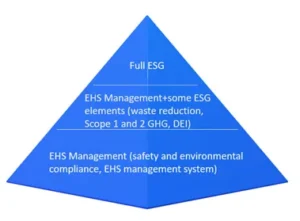
By improving your management of EHS risks and getting the tools in place to sustain good practices, you’re giving yourself a good foundation on which to build ESG initiatives.
Looking for Additional Information?
- For a comprehensive overview of the many ways risk bowties help improve better risk management, download our guide Using Risk Bowties to Manage Risk, or watch our on-demand webinar Bowtie Analysis Tools: How Successful Companies Manage Risk.
- If you’re just looking for a briefer overview that you can use to help build a case for your organization to start using risk bowties, our infographic Risk Bowties: A Tool for Risk Management and Training might be just what you need.
- EHS managers who want to better understand how bowties combine information from many different kinds of risk assessments can download our interactive infographic Bowties: A Unified View of Operational Risk. And if you want a really deep dive into how to create and use good risk bowties, register for one of the upcoming dates of our 8-hour, 2-day training course.
- To learn more about a real-life accident that shows how risk bowties can help manage risk for complex processes with significant safety and health risks, be sure to check out our on-demand webinar Thunder River Rapids: A Case Study in Process Safety and Risk Management.
- If you’d like to better understand how a safety management system modeled on ISO 45001 can help you develop the kind of engagement and participation that leads to greater EHS/ESG maturity, watch our on-demand webinar All About ISO 45001: Understanding the Standard and What It Means for You.
- Finally, if you’d like to learn more about how to navigate the journey from EHS management to ESG maturity, download our infographic.
- We hope that our discussion of EHS risks throughout this series and these additional resources will be helpful to you as you continue your path as an EHS management professional. Please feel free to follow us on LinkedIn, where you’ll always find updates on the worlds of EHS and ESG that will further support your efforts to create a safer and more sustainable workplace.
Let VelocityEHS Help!
The Operational Risk solution in our VelocityEHS Accelerate® Platform can give you just the support you need to build better practices that hold your whole EHS management system together. We give you capabilities for risk bowties, HAZIDS, HAZOPs, qualitative and quantitative risk analysis, layers of protection analysis (LOPA), critical controls verification and much more!
Ready to see more? Visit our Operational Risk page to request a demo with one of our customer solutions consultants today or contact us anytime to learn more about how we can support you on your EHS/ESG journey.
